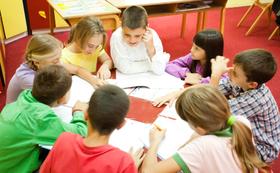Recess has traditionally been a part of the school day in public elementary schools, offering students the opportunity to breathe in fresh air, work off energy, and socialize with friends outside the confines of the classroom. However, in the interest of providing additional instruction during the school day, many schools have moved away from recess in favor of more classroom time. In some areas, recess has been on hiatus for years, but parents and educators are joining together in a movement to resuscitate recess after finding numerous benefits this time of free play provides. This article will take a look at some of the schools that have done away with the popular playtime and why many are bringing the ritual back to their playgrounds.
This video discusses eliminating a recess break.
The Benefits of Recess
While recess may not seem to have many benefits to daily studies on the surface, research into the matter seems to prove otherwise. On their website, the cites numerous benefits of recess, which impact the students' physical, emotional, cognitive, and social health and wellbeing. Some of the physical benefits of recess include:
- More time spent in active play
- Proper growth and development from physical activity
- Helps children maintain a healthy weight, reducing the risk of some diseases later in life
- Improves bone mass and density, lowering the risk of fractures throughout life
There are also cognitive and social benefits of recess time, which include:
- Better focus in the classroom
- Increased academic achievement
- Provides time for self-directed play and cultivates imagination
- Development of social skills with peers
- Understanding of how behaviors affect their playtime
Children who spend more times playing outdoors even experience emotional benefits from the habit, including:
- Less stress and reduced anxiety
- Improved self-esteem and self-worth
- Offers time to play out real scenarios for a better understanding of them
- Allows children who need time to themselves a needed break
In addition, regular recess time builds health habits in children because it encourages a lifestyle that reduces the risks of some types of diseases through fun physical activity. The report from the Florida Department of Health also makes the point that teachers and other working adults have breaks scheduled into their workdays. If adults recognize the need for breaks, why do some schools not see the same need for their students?
This video looks at the benefits of recess.
Recess Before Lunch
In addition to the many benefits of daily research cited above, there are also advantages to scheduling recess right before lunchtime. These benefits, according to the , include:
- Children consume more nutrients and waste less food
- Children can eat at a more leisurely pace
- Children behave better at school throughout the day
- Students perform better in the classroom, thanks to their improved nutritional intake
- Students return to the classroom better prepared to tackle their studies
Despite these research findings, many schools still schedule recess after a short lunchtime, leaving students to wolf down their food in the interest of getting outdoors sooner. In some schools, the short lunch is all there is, and recess doesn't even come into the equation.
Next, we'll take a look at why some schools are hoping to reverse their recess-free trend by adding that important playtime back into the regular school schedule.
Recess-Free Chicago
Chicago is one of the cities working to get recess reinstated in schools today. Advocates are looking into adding 45 minutes to the regular school day – not for additional study time, but so that students can get outdoors for playtime that has not been included in the daily schedule for as long as 38 years in some grammar schools in the Chicago area.
Chicago Teachers Union President Karen Lewis told the that she supports bringing recess back into the schools in Chicago by moving teachers' lunchtimes from the end of the day to the middle of the schedule.
"Recess is good for kids and it's good for teachers," Lewis told the Sun-Times. "It's a win-win."
This month, a group in Chicago, dubbed the Raise Your Hand parent coalition, launched a series of instructional seminars to educate parents on steps to restore recess in Chicago schools that have gone without for some time. Illinois is also hosting a task force to discuss how to implement recess statewide. However, there are some hurdles that must be crossed before recess can become a reality for some schools.
"You have to take into consideration whether there is a place to accommodate recess," Lewis said. "A lot of schools don't even have outdoor places for kids to play…I would encourage teachers to look at the options available to them and how it will work in their schools."
This video looks at the pros and cons of recess.
Recess for the Rich, but Not the Poor?
Another interesting study reported by a few short years ago suggests that students coming from wealthier households are more likely to have recess in schools. The study found that first-graders in the wealthiest schools got an average of 31.8 minutes of recess every day. On the other hand, students in the poorest schools only enjoyed 21 minutes of daily play outdoors. This gap appears to be consistent with grades throughout elementary school.
However, recess becomes even more significant to students who come from poverty-stricken, crime-rich areas. A 2008 Chicago Sun-Times series found that outdoor play is more important for students who come from these types of areas, since parents may be afraid to let their children play outdoors at home.
While Chicago continues to debate how to implement recess in schools, one thing appears crystal clear – students who spend time outdoors spend more productive hours in the classroom as well.
Questions? Contact us on Facebook. @publicschoolreview















